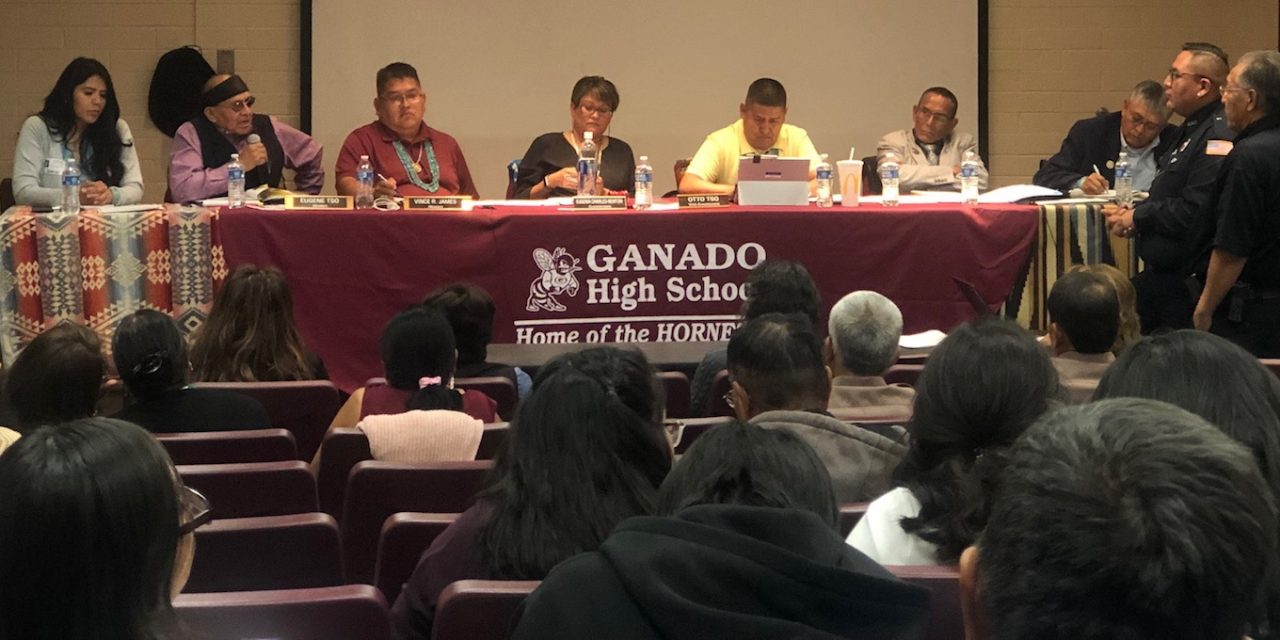
Ganado Fire District: Nation’s fire department not pulling its weight

Navajo Times | Arlyssa Becenti Committee members listen to a report from the Ganado Fire Department.
GANADO, Ariz.
When the previous Navajo Nation Council passed legislation to reallocate 17 percent of the sales tax to the Department of Fire and Rescue Services, it was with the notion that the money would help protect individuals and communities.
But during the Oct. 7 meeting of the Law and Order Committee at Ganado High School, Ganado Fire District officials said the Navajo Nation Fire Department isn’t exactly pulling its weight — so much so that the small district has to pick up the slack.
“We are going the extra mile to meet the needs of our customers and we are asking of the committee to recognize it and to see if the Navajo Nation (Fire Department) is willing to put their effort to provide this type of assistance for the customers for the Nation,” said Marcarlo Roanhorse, Ganado Fire District administrative assistant.
“We have to go out of our coverage area to assist Navajo Nation, which we don’t have an issue with,” he said. “But it is a concern when we leave our coverage area to provide coverage on Navajo Nation area.”
The Ganado Fire Department has two substations, in Steamboat and Klagetoh, and unlike the Navajo Nation’s, Ganado doesn’t receive any financial assistance from the Nation.
Its coverage area includes Klagetoh, Steamboat, Ganado, Cornfields and Kinlichee.
Roanhorse said 80 percent of its nearly $750,000 annual budget comes from taxes from three different sources, including El Paso Natural Gas and Salt River Project. The other 20 percent comes from county fire district taxes.
“We aren’t here to fight with the Nation,” said Roanhorse. “We are trying to work with them as one Nation. I know there’s leaders at the Navajo Nation who sees us as a threat and don’t want to work with us.”
In addition to community fire departments like Ganado’s, there are seven fire departments scattered throughout Navajo that are operated by the Nation, employing 18 full-time firefighters.
When the previous Council approved the 17-percent set-aside, it stipulated that a fund management plan would have to be approved by the Budget and Finance Committee.
LOC Chair Eugenia Charles-Newton wondered what had become of the $8 million allocated to fire and rescue from the recent fiscal year.
“Where is that money going?” asked Charles-Newton, adding that she was not aware Ganado’s fire department was not part of the Navajo Nation network.
“That’s our responsibility as delegates because we appropriate those monies, to ask where is that money going?” she said. “We receive complaints from the community … to me it seems those services aren’t being provided.”
In addition to providing fire and rescue services, the Ganado Fire District offers community training in CPR, first aid, fire safety and basic life support, said Roanhorse. They also assist wildland firefighters.
LOC member Vince James said he was thankful for his community’s fire district for “stepping up” and providing CPR training for the community, adding he’s not aware whether the Navajo Nation Fire Department is providing those classes for the Nation.
“I know you have individuals who come from Chinle, Sanders – that come all the way from Dilkon – to sit through your CPR training,” said James, “because it’s needed. Your concern of where the Nation is stepping in, that’s really interesting to hear.”
In a brief interview with the Times, Navajo Nation Fire Department Capt. John Williams said the department wasn’t notified or invited to this Law and Order meeting.
“They do whatever they’re doing,” said Williams about Ganado Fire District’s list of services.
He also added that some of the firefighters with Ganado Fire District were part of the Navajo Nation Fire Department Academy.
Williams said the tribal department has reached out to non-tribal fire districts, including Ganado, to establish a memorandum of agreement with them, but hasn’t received any response.
As for the $8 million, Williams said they are finally getting a new fleet of fire trucks and a lot of that money is going there. The trucks they are currently using are 12 years old, and by National Fire Protection Association standards a truck should only be used for 10 years.
But in some New Mexico fire stations operated by the Nation, some of the trucks are about 26 years old.
“Most of the money is being used to purchasing new and updated equipment per National Fire Protection Association standards,” said Williams. “The costs do increase with each new mandate NFPA requires. We need to better serve our Navajo people with new and updated, reliable equipment.”
LOC Vice chair Otto Tso, who was also a member of LOC when the reallocation legislation was passed, told Ganado Fire District that “it don’t hurt” to ask for help from the Navajo Nation, especially in the form of an MOA, or for some of the sales tax funds.
“There’s governmental entities, like yourself, that can come to the table and ask for your fair share based on the people that buy in this community,” said Tso.
“It’s time to bring in Kayenta Township, Oljato, Montezuma Creek … to amend sales tax to indicate the funding revenue should go to Ganado Fire District, Kayenta Township,” he said. “The Navajo Nation hasn’t contributed one cent there. People are contributing to that sales tax. You’re not getting the service you’re supposed to be provided.”
Williams said he’s fine with sharing the funds with Ganado and Kayenta, but if that were to happen then those fire districts would have to conform to the Navajo Nation Fire Department program.
“We follow policy and guidelines set by the Navajo Nation,” said Williams.







 Highway 264,
Highway 264, I-40, WB @ Winslow
I-40, WB @ Winslow